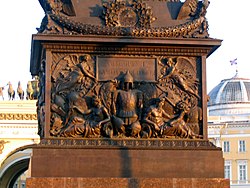Country: Russia
Distance: 719 km
Travel time: 15 days
On postcard: Palace Square. Alexander Column.
Palace Square (Russian: Дворцовая площадь, Dvortsovaya Ploshchad), connecting Nevsky Prospekt with Palace Bridge leading to Vasilievsky Island, is the central city square of St Petersburg and of the former Russian Empire. It was the setting of many events of worldwide significance, including the Bloody Sunday (1905) and the October Revolution of 1917.
The earliest and most celebrated building on the square is the baroque white-and-azure Winter Palace of Russian tsars (1754–62), which gave the square its name. Although the adjacent buildings are designed in the Neoclassical style, they perfectly match the palace in their scale, rhythm, and monumentality. The opposite, southern side of the square was designed in the shape of an arc by George von Velten in the late 18th century. These plans were executed half a century later, when Alexander I of Russia envisaged the square as a vast monument to the Russian victory over Napoleon and commissioned Carlo Rossi to design the bow-shaped Empire-style Building of the General Staff (1819–29), which centers on a double triumphal arch crowned with a Roman quadriga.
The centre of the square is marked with the Alexander Column (1830–34), designed by Auguste de Montferrand. This red granite column (the tallest of its kind in the world) is 47.5 metres high and weighs some 500 tons. It is set so well that no attachment to the base is needed.
The eastern side of the square is occupied by Alessandro Brullo's building of the Guards Corps Headquarters (1837–43). The western side, however, opens towards Admiralty Square, thus making the Palace Square a vital part of the grand suite of St Petersburg squares.
The square also serves as open-air venue for concerts by international acts, including Andrea Bocelli, Roger Waters, The Rolling Stones, AC/DC, Duran Duran, Anastacia, Elton John, Paul McCartney, Shakira, Madonna, Sting.
The Alexander Column (Russian: Алекса́ндровская коло́нна, Aleksandrovskaya kolonna) also known as Alexandrian Column (Russian: Александри́йская коло́нна, Aleksandriyskaya kolonna), is the focal point of Palace Square in Saint Petersburg, Russia. The monument was erected after the Russian victory in the war with Napoleon's France. Named after Emperor Alexander I, who ruled Russia between 1801 and 1825, the column is an interesting piece of architecture and engineering.
Column
The Alexander Column was designed by the French-born architect Auguste de Montferrand, built between 1830 and 1834 with Swiss-born architect Antonio Adamini, and unveiled on 30 August 1834. The monument — the tallest of its kind in the world — is 47.5 m (155 ft 8 in) tall and is topped with a statue of an angel holding a cross. The statue of the angel was designed by the Russian sculptor Boris Orlovsky. The face of the angel bears great similarity to the face of Emperor Alexander I.
The top of the column, showing statue of an angel holding a cross
The column is a single piece of red granite, 25.45 m (83 ft 6 in) long and about 3.5 m (11 ft 5 in) in diameter. The granite monolith was obtained from Virolahti, Finland and in 1832 transported by sea to Saint Petersburg, on a barge specially designed for this purpose, where it underwent further working. Without the aid of modern cranes and engineering machines, the column, weighing 600 tonnes (661 tons), was erected by 3,000 men under the guidance of William Handyside in less than 2 hours. It is set so neatly that no attachment to the base is needed.
Pedestal
The pedestal of the Alexander Column is decorated with symbols of military glory, sculpted by Giovanni Battista Scotti.
On the side of the pedestal facing the Winter Palace is a bas-relief depicting winged figures holding up a plaque bearing the words "To Alexander I from a grateful Russia". The composition includes figures representing the Neman and Vistula rivers that were associated with the events of the Patriotic War. Flanking these figures are depictions of old Russian armour - the shield of Prince Oleg of Novgorod, the helmet of Alexander Nevsky, the breastplate of Emperor Alexander I, the chainmail of Yermak Timofeyevich and other pieces recalling heroes whose martial feats brought glory to Russia.
Pedestal decorations of Alexander column
The other three sides are decorated with bas-reliefs featuring allegorical figures of Wisdom and Abundance, Justice and Mercy, Peace and Victory, the last holding a shield bearing the dates 1812, 1813 and 1814. These compositions are enhanced by depictions of Ancient Roman military symbols and Russian armour.
The sketches for the bas-reliefs were produced by Auguste de Montferrand. He coordinated the scale of their compositions with the monumental forms of the monument. The panels were designed to the planned size by the artist Giovanni Battista Scotti. The models were produced by the sculptors Piotr Svintsov and Ivan Lepee, the ornamental embellishments by sculptor Yevgeny Balin. The casting of the bronze was done at Charles Baird's works in Saint Petersburg.
Later years
In 1952, according to some recent reports, the authorities of the Soviet Union secretly planned to replace the statue of the angel with a statue of Joseph Stalin. A historic iron fencing around the column was demolished during the Soviet period. The fencing was restored in 2002.
















0 коммент.:
Отправить комментарий